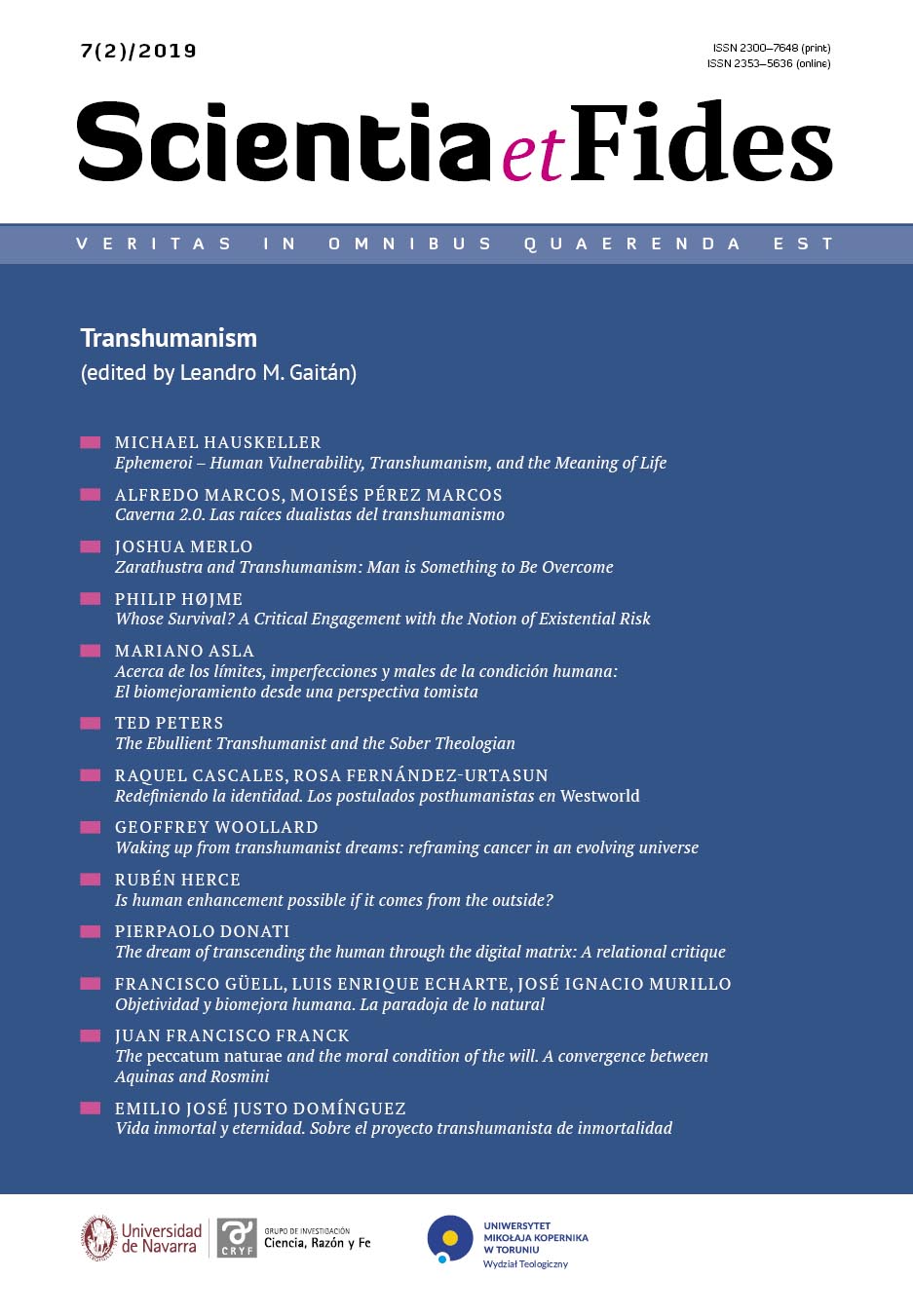The Ebullient Transhumanist and the Sober Theologian
Słowa kluczowe
transhumanism, H , superintelligence, Singularity, radical life extension, cybernetic immortality, Gnosticism, public theologyAbstrakt
The worldwide transhumanist (H+) movement upgrades technological hopes and expectations to a level of religious fervor. When looking through the eyes of the public theologian, we see in H+ a disguised religion replete with faith in techno-salvation and even immortality. This is unrealistic. Apologetic theologians can offer the wider public a more realistic assessment of technology's potential while providing genuine hope in a future vision based on divine promise.Bibliografia
Alexander, Brian, 2003. Rapture: How Biotech Became the New Religion. New York: Basic Books.
Barbour, Ian G., 1999. "Neuroscience, Artificial Intelligence, and Human Nature: Theological and Philosophical Reflections." Zygon 34:3 (September) 361-398.
Bostrom, Nick, 2019. "What is Transhumanism?" https://nickbostrom.com/tra/values.html.
Cannon, Lincoln. 2015. "What is Mormon Transhumanism?" Theology and Science 13:2 (May) 202-218.
Cole-Turner, Ronald. 2015. "Going Beyond the Human: Christians and Other Transhumanists." Theology and Science 13:2 (May) 150-161.
Curran, Ian. 2017. "Becoming godlike? The Incarnation and the Challenge of Transhumanism." Christian Century 134:24 (November 22) 22-25.
DeGrey, Aubrey. 2009. "Radical Life Extension: Technological Aspects." Religion and the Implications of Radical Life Extension, eds., Derek F. Maher and Calvin Mercer. New York: Macmillan Palgrave; 13-24.
DeGrey, Aubrey. 2016. "Forever Young." https://stemcellpodcast.com/ep-62-forever-young-featuring-dr-aubrey-de-grey.
Foerst, Anne (1998) "Cog, a Humanoid Robot, and the Question of the Image of God," Zygon 33:1 (March) 91-112.
Francis, His Holiness. 2015. Communion and Stewardship: Human Persons Created in the Image of God. The Vatican: International Theological Commission, Congregation for the Doctrine of the Faith. http://www.vatican.va/roman_curia/congregations/cfaith/cti_documents/re_con_cfaith_doc.
Francis Fukuyama, Francis, 2004. "Transhumanism: The World's Most Dangerous Idea." Foreign Policy 144: 42-43.
Green, Brian Patrick. 2015. "Transhumanism and Roman Catholicism: Imagined and Real Tensions." Theology and Science 13:2 (May) 187-201.
Green, Brian Patrick. 2018. "Ethical Reflections on Artificial Intelligence." Science et Fides 6:2: 1-23. http://apcz.umk.pl/SetF/article/view/SetF.2018.015/15729.
Harari, Yuval Noah. 2017. Homo Deus: A Brief History of Tomorrow. New York: Harper.
Herzfeld, Noreen L., 2002. In Our Image: Artificial Intellitgence and the Human Spirit. Minneapolis: Fortress Press.
Humanity +, 2018. https://humanityplus.org/ .
Investopedia. 2018. https://www.investopedia.com/terms/a/artificial-intelligence-ai.asp .
Jones, D. Gareth, 2010. "A Christian Perspective on Human Enhancement," Science and Christian Belief 22:2: 14-16.
Kirkwood, Thomas B.L. 2008. “A systematic look at an old problem,” Nature 451: 7179: 644-647 (7 February ) 645.
Anne Kull, Anne. 2016. "Cyborg or Religious? Technonature and Technoculture." Science et Fides 4:1 (January) 295-311. http://apcz.umk.pl/SetF/article/view/SetF.2016.016/8762 .
Kurzweil, Ray, 2005. The Singularity is Near: When Humans Transcend Biology. New York: Penguin.
Kwon, Diana. 2018. "Self-Taught Robots," Scientific American 318:3 (March ) 26-31.
LaTorra, Michael, 2015. "What is Buddhist Transhumanism?" Theology and Science 13:2: 219-229.
Levy, Neil, 2016. "The Earthling's Secret Weapon: Cumulative Culture and the Singularity, Science, Religion and Culture 3:1: 19-30; file:///C:/Users/Ted/Downloads/1468597863SRC_3_1_19-30%20(3).pdf .
Lynch, Michael Patrick. 2018. Cited by The Guardian, "Where is the boundary between your phone and your mind?" (December 9); https://www.theguardian.com/us-news/2018/dec/09/tech-mind-body-boundary-facebook-google?CMP=share_btn_link
More, Max, 2005. "The Philosophy of Transhumanism," http://media.johnwiley.com.au/product_data/excerpt/10/11183343/1118334310-109.pdf .
Pelikan, Jaroslav, 1971-1989. The Christian Tradition: A History of the Development of Doctrine. 5 Volumes: Chicago: University of Chicago Press.
Peters, Ted, 2009. “Afterword: Theological, Spiritual and Ethical Reflections on Radical Life Extension.”Religion and the Implications of Radical Life Extension, edited by Derek Maher and Calvin Mercer. New York: Palgrave Macmillan; 155-168.
Peters, Ted, 2010. “Can We Enhance the Imago Dei?” Human Identity at the Intersection of Science, Technology, and Religion, edited by Nancey Murphy and Christopher C. Knight. Aldershot UK: Ashgate; 215-238.
Peters, Ted, 2011. “Transhumanism and the Post-Human Future: Will Technological Progress Get us There?” H+ Transhumanism and Its Critics, edited by William Grassie and Gregory Hansell. Philadelphia: Metanexus Institute; 147-175.
Peters, Ted, 2016. "Outer Space and Cyber Space: Meeting ETI in the Cloud," International Journal of Astrobiology doi:10.1017/S1473550416000318 © Cambridge University Press.
Peters, Ted, 2018a. "Imago Dei, DNA, and the Transhuman Way"Theology and Science 16:3 (August).353-362. https://doi.org/10.1080/14746700.2018.1488529 .
Peters, Ted, 2018b. "Markers of Human Creaturehood: Soil, Spirit, and Salvation." Science and Christian Belief 30:2:143-154.
Peters, Ted, 2018c. "Radical life extension, cybernetic immortality, and techno-salvation. Really?" Dialog 57:4 (December) https://doi.org/10. 1111/dial.12432 .
Peters, Ted, 2018d. “Public Theology: Its Pastoral, Apologetic, Scientific, Political, and Prophetic Tasks,” International Journal of Public Theology 12:2: 153-177; https://brill.com/abstract/journals/ijpt/12/1/ijpt.12.issue-1.xml .
Pryor, Adam, 2016. "Cyborg Bodies as the Subject of Ultimate Concern," Bulletin of the North American Paul Tillich Society 42:3 (Summer 2016 ) 13-19; http://www.napts.org/assets/newsletters/NB423.pdf .
Russell, Stuart, 2016. "Should We Fear Supersmart Robots?" Scientific American 314:6 (June ) 58-59. http://www.scientificamerican.com/article/should-we-fear-supersmart-robots/.
Singh, Sarwandt, 2017. "Transhumanism and the Future of Humanity: 7 Ways the World Will Change by 2030," Forbes (November 20); https://www.forbes.com/sites/sarwantsingh/2017/11/20/transhumanism-and-the-future-of-humanity-seven-ways-the-world-will-change-by-2030/#430a779a7d79
Tillich, Paul, 1951-1963. Systematic Theology. 3 Volumes: Chicago: University of Chicago Press.
Tirosch-Samuelson, Hava. 2018. "In Pursuit of Perfection: The Misguided Transhumanist Vision." Theology and Science 16:2 (May) 200-223.
Tracy, David, 1994. On Naming the Present: God, Hermeneutics, and Church. Maryknoll NY and London: Orbis and SCM Press.
Vinge, Verner, 1992. "What is the Singularity," https://mindstalk.net/vinge/vinge-sing.html.
Wertheim, Margaret, 1999. The Pearly Gates of Cyberspace: A History of Space from Dante to the Internet. New York: W.W. Norton.
Young, Simon. 2006. Designer Evolution: A Transhumanist Manifesto. Amherst, NY: Prometheus Books.
Pobrania
Opublikowane
Jak cytować
Numer
Dział
Licencja
CC BY ND 4.0. Posiadaczem prawa autorskiego (Licencjodawcą) jest Autor, który na mocy umowy licencyjnej udziela nieodpłatnie prawa do eksploatacji dzieła na polach wskazanych w umowie.
- Licencjodawca udziela Licencjobiorcy licencji niewyłącznej na korzystanie z Utworu/przedmiotu prawa pokrewnego w następujących polach eksploatacji: a) utrwalanie Utworu/przedmiotu prawa pokrewnego; b) reprodukowanie (zwielokrotnienie) Utworu/przedmiotu prawa pokrewnego drukiem i techniką cyfrową (e-book, audiobook); c) wprowadzania do obrotu egzemplarzy zwielokrotnionego Utworu/przedmiotu prawa pokrewnego; d) wprowadzenie Utworu/przedmiotu prawa pokrewnego do pamięci komputera; e) rozpowszechnianie utworu w wersji elektronicznej w formule open access na licencji Creative Commons (CC BY-ND 3.0) poprzez platformę cyfrową Wydawnictwa Naukowego UMK oraz repozytorium UMK.
- Korzystanie przez Licencjobiorcę z utrwalonego Utworu ww. polach nie jest ograniczone czasowo ilościowo i terytorialnie.
- Licencjodawca udziela Licencjobiorcy licencji do Utworu/przedmiotu prawa pokrewnego nieodpłatnie na czas nieokreślony
PEŁEN TEKST UMOWY LICENCYJNEJ >>
Statystyki
Liczba wyświetleń i pobrań: 1167
Liczba cytowań: 1



